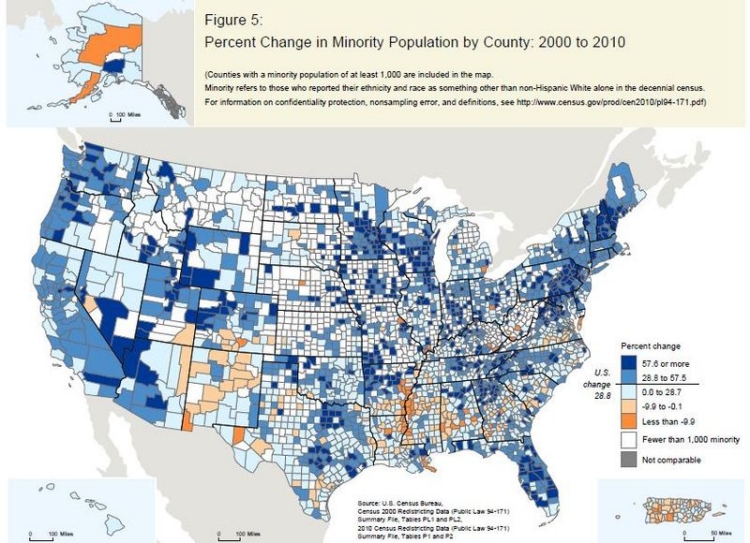Race and Hispanic Origin and the 2010 Census
Race and Hispanic Origin and the 2010 Census
During the 2010 Census, questions on race and Hispanic origin were asked of every individual living in the United States. These data provide a snapshot of race and Hispanic origin in the United States.
According to the 2010 Census, 308.7 million people resided in the United States on April 1, 2010, an increase of 27.3 million people, or 9.7 percent, between 2000 and 2010. The vast majority of the growth in the total population came from increases in those who reported their race(s) as something other than White alone and those who reported their ethnicity as Hispanic or Latino.
More than half of the growth in the total population of the United States between 2000 and 2010 was due to the increase in the Hispanic population.
Between 2000 and 2010, the Hispanic population grew by 43 percent. The Hispanic population increased by 15.2 million between 2000 and 2010, accounting for over half of the 27.3 million increase in the total population of the United States.
The overwhelming majority of the total population of the United States reported only one race in 2010.
In the 2010 Census, 97 percent of all respondents reported only one race. The largest group reported White alone (72 percent). The Black or African American alone population represented 13 percent of the total population. In addition, 0.9 percent of respondents indicated American Indian and Alaska Native alone and about 5 percent identified their race as Asian alone. The smallest major race group was Native Hawaiian and Other Pacific Islander alone, representing 0.2 percent of the total population.
The examination of racial and ethnic group distributions nationally shows that while the non-Hispanic White alone population is still numerically and proportionally the largest major race and ethnic group in the United States, it is also growing at the slowest rate.
Throughout the decade, the Census Bureau will release additional information on race and Hispanic origin population groups, which will provide more insights to the nation’s racial and ethnic diversity.
Hispanic origin can be viewed as the heritage, nationality group, lineage, or country of birth of the person or the person’s parents or ancestors before their arrival in the United States. People who identify their origin as Hispanic, Latino, or Spanish may be of any race.
Data on race have been collected since the first U.S. decennial census in 1790. The 2010 Census question on race included 15 separate response categories and three areas where respondents could write in detailed information about their race. In addition to White, Black or African American, American Indian and Alaska Native, and Some Other Race, seven of the 15 response categories are Asian groups and four are Native Hawaiian and Other Pacific Islander groups.
How do data from the question on Hispanic origin and race benefit me, my family, and my community?
All levels of government need information on Hispanic origin and race to implement and evaluate programs, or enforce laws. Examples include: the Civil Rights Act, the Voting Rights Act, the Fair Housing Act, the Equal Employment Opportunity Act, and the Census Redistricting Data Program.
Both public and private organizations use Hispanic origin and race information to find areas where groups may need special services and to plan and implement education, housing, health, and other programs that address these needs. For example, a school system might use this information to design cultural activities that reflect the diversity in their community. Or a business could use it to select the mix of merchandise it will sell in a new store. Census information also helps identify areas where residents might need services of particular importance to certain racial or ethnic groups, such as screening for hypertension or diabetes.
Karen R. Humes, Assistant Division Chief for Special Population Statistics, Population Division
Nicholas A. Jones, Chief, Racial Statistics Branch, Population Division
Roberto R. Ramirez, Chief, Ethnicity and Ancestry Branch, Population Division





